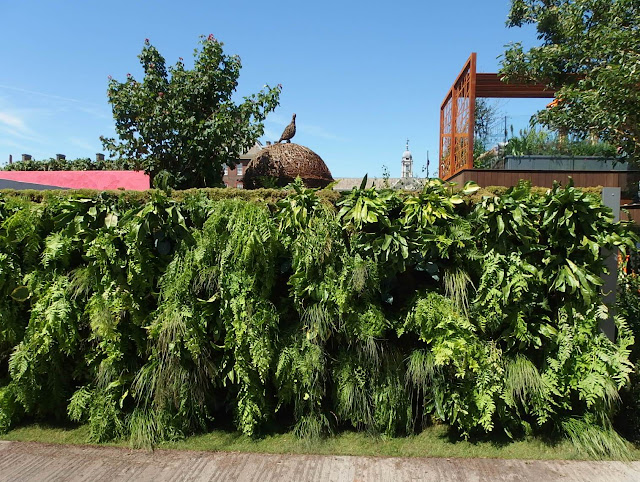The Great Green Wall Hunt: At Chelsea Flower Show
Green walls were a must-have for Nigel Dunnett's garden for Greening Grey Britain, so it was no surprise there were two of them incorporated into his design. The one which interested me most was found at the back, enlivened by Jo Peel's street art.
This turned out to be a new-to-me type of green wall; low(er) in cost and lightweight, and designed to hang in order to hide ugly facades or fences. The wall contains a seed mix of fescue and wildflowers and was started around 4 weeks ago ready for the show. Unlike most green walls, this one is usually hung just after seeding and would initially be brown.
Like other walls of this type it has an irrigation system at the top which could be run off a rainwater harvesting system. I was surprised to find it's only designed to last around three years, so it might be a better proposition (in my view) as a temporary installation, as an alternative to the ivy screens such as those used currently by the Crossrail project (see here for an example). Whether it's viable as a longer term solution depends on the initial and replacement costs involved.
Over in the Fresh gardens, Kate Gould's innovative City Living design included a couple of the more familiar, verdant living walls I've seen in public places.
The difference here was a new-to-me supplier, called Gro-Wall. When I peered into the foliage, it looked like the planting pockets for this design are much deeper than the ones I've found in previous Great Green Wall Hunts. The blurb on the RHS website (see above link) confirms my findings:
"The living wall uses larger than normal planting trays..., meaning that a wider range of specimens can be used, including tropical plants. Shade loving plants have been planted at the bottom of the wall, while sun lovers are at the top where they have access to more light."
I found a surprise green wall at the back of Matt Keightley's design for Radio 2's Jeremy Vine Texture Garden, where the rounded moss balls certainly added texture to the feature wall. It's a shame they weren't repeated throughout the design, though I suspect these are quite hard to supply in vast quantities.
We usually see these as a signature feature in Kazuyuki Ishihara's designs. Don't worry, he had them in his Gosho No Niwa No Wall, No War garden as well (click to enlarge if needed).
Not to be outdone, the Great Pavilion sported at least two examples of green walls and I was pleased to find an edible version on Tom Smith's exhibit. This is a great way of extending edible space in small gardens and can easily be replicated on a budget using drainpipes or pallets as planters.
Just through the greenhouse door you can see the world's hottest chilli Tom's son Mike bred, which is now being researched by Nottingham Trent University as a possible anaesthetic (remember how numb your mouth goes when you have a hot chilli sauce?).
To the right we have the British Ecological Society's Delight in the Dark exhibit, which demonstrates the way some plants are adapted for life in the shade. It's the first time I've seen a torch used to explain an exhibit, to simulate different light levels and how plants adapt to the shade itself, or are vernal i.e. they flower in spring when there's less shade from the canopy above.
The internet also offers some relatively cheap (though much smaller) and DIY options which use moss or succulents as the planting material. Information on how long these living pictures last isn't readily available.
These are all options which merit further investigation for The Great Green Wall Hunt when the opportunity next presents itself.

















Love the shady one, so dark and green and cool-looking. Let's hope we start to see more green walls around.
ReplyDeleteSince I've started my hunt CJ, I've found there's a lot more of them cropping up around the country. There are simpler solutions available too e.g. ivy screens, but they're not quite as diverse in the planting material used.
DeleteI wonder whether our prefabricated garage wall would support a green wall.
ReplyDeleteIt would depend on the strength of the walls Sue. I've just been reading the Chelsea preview in my Garden Answers magazine and he admits that wall was very experimental. Whilst it's relatively lightweight and uses less water, I don't know how well it might translate to the domestic market. Do you have any soil nearby? Then climbers such as clematis or ivy might be a better bet (and cheaper and less complicated!)
DeleteHey dear Michelle,
ReplyDeleteIt is great to read your blog.
Have a wonderful day.
Marijke
What a lovely thing to say Marijke, thank you :)
Delete